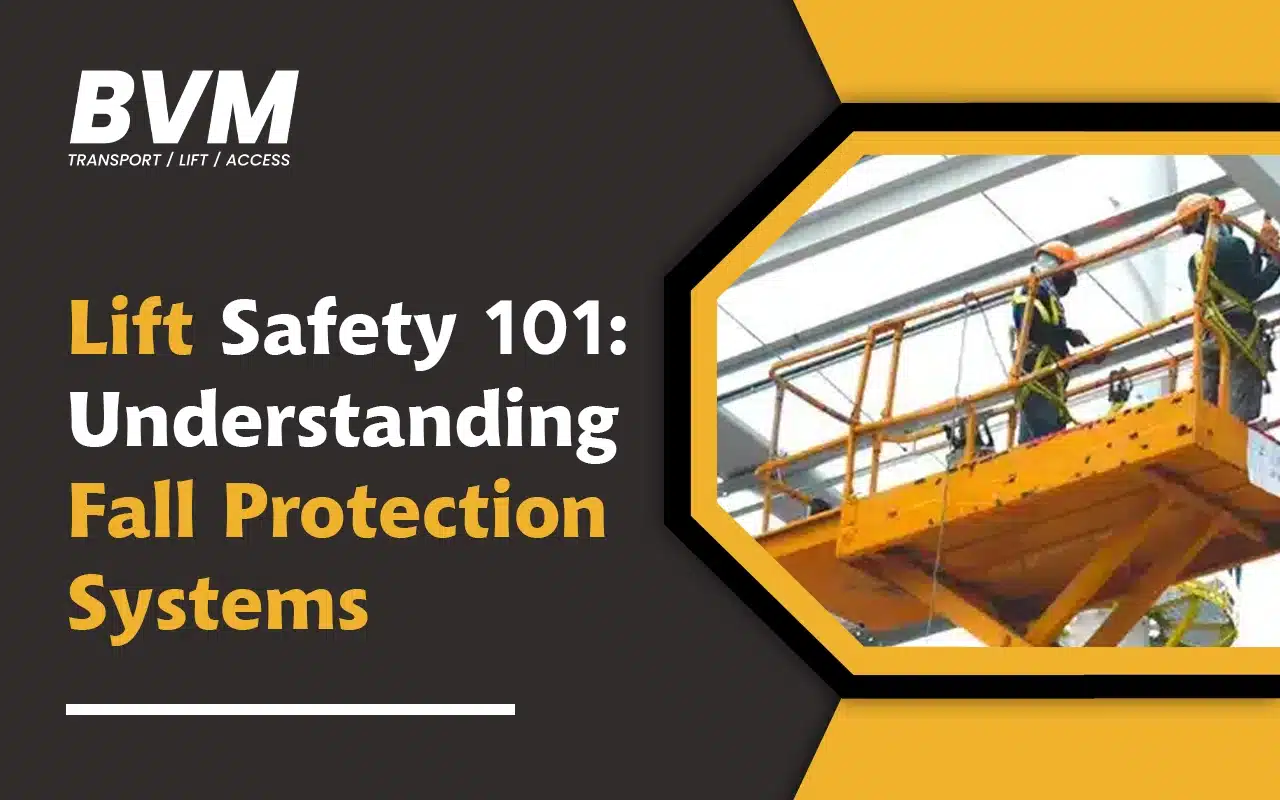
When operating aerial lifts and other elevated work platforms, proper fall protection systems are absolutely vital to mitigate the risk of serious or deadly falls.
In this article, we explain what a fall protection system entails, including body support, and connecting devices that together prevent falls at height.
We discuss why rigorous fall protection is not only crucial for lift operator safety but often legally required across worksites as well.
So, let’s start with a fundamental understanding of this essential safety system for elevated work.
What is a Fall Protection System?
A fall protection system is a comprehensive set of safety equipment and procedures to prevent workers from falling off elevated platforms.
Such a system typically includes harnesses attached to anchor points, lanyards or retractable lifelines to secure the worker, guardrails installed at platform edges, and safety nets below the lift to catch from potential falls.
When properly used, these components work together to mitigate the risks of working at heights across various industries and worksites where lifts are utilized.
Why Fall Protection is Needed To Operate Lifts?
Aerial Lifts and Scissor Lifts operations are prone to fall tragedies. To ensure safe operations, we’ll contrast how aerial lifts and scissor lifts differ regarding mandatory safety protocols to save the worksite managers and labourers.
Understand Fall Hazards Associated with Lifts
Aerial Lifts
Aerial lifts also known as boom lifts consist of a hydraulic boom with a platform basket at the end. The articulating design enables vertical and horizontal reach for accessing building exteriors, warehouses, transmission towers, and other challenging spaces.
Risks include falls from tip-overs, improper positioning, bucket ejections, or improper harness tie-offs. Suspension trauma also poses dangers during prolonged rescues.
Scissor Lifts
Scissor lifts provide pure vertical travel via a linked, crisscrossed elevation mechanism raising the work platform. Limited range yet larger capacity ideal for interior spaces.
Hazards include falls from improperly installed guardrails, working past edges, or makeshift ramps tipping units. Electrocution and crush risks factor as well as near structures and machinery.
Required Fall Protection for Aerial Lifts
For aerial lifts, OSHA mandates workers wear personal fall arrest systems (PFAS) while working from boom buckets. Why?
PFAS typically include full-body harnesses secured to boom/basket anchor points via shock-absorbing lanyards or self-retracting lifelines. These arrest free falls rapidly while also absorbing kinetic energy generated.
Without PFAS, ejections from aerial lift platforms at height would almost surely cause severe injury or death. But properly utilized PFAS prevents both stopping falls instantly and reducing impact trauma overall.
Required Fall Protection for Scissor Lifts
Scissor lift platforms stand apart in already having integrated guardrails installed around their perimeter while working at height. This built-in barrier provides a passive yet effective means of fall prevention assuming the rails are:
- Properly Anchored
- Free of Damage
- At least 39-45 inches high per OSHA codes depending on the construction date
Note however that while guardrails satisfy scissor lift fall protection minimums, OSHA advises also wearing PFAS equipment as an extra precaution for considering scenarios like:
- Guardrail gaps exceeding 19 inches
- Accessing areas beyond guardrails
- Job sites with frequent edge proximity
- Task scaling/climbing needs arise
In essence, integrated guardrails serve as the baseline while harness systems become mandatory for higher-risk conditions or locations. Better to err on the side of caution as lives are on the line.
Why Investing in Fall Protection Saves Lives
OSHO statistics revealed in 2020, Falls were the leading cause of death in construction. In 2020, there were 351 fatal falls to a lower level out of 1,008 construction fatalities. Beyond this, paralysis, blunt trauma, broken limbs, and high worker’s compensation liabilities loom as additional threats to health, well-being, and company security alike.
According to the National Safety Council (NSC), in 2021 With towering workplace injury costs averaging over $167.0 billion yearly nationwide, implementing proper fall protection quite literally saves money as much as lives for companies.
And manager’s legal and ethical mandates here couldn’t be more pronounced according to all safety experts.
Thankfully, today’s comfortable and innovative fall protection equipment boasts dexterity alongside durability for maneuvering tight overhead spaces without hindrances.
No sacrifices in practical mobility need to compromise safety. Best of all, essential setups are quite affordable even on smaller operating budgets.
So in short – no viable excuses exist to justify unprotected aerial and scissor lift work given such grave stakes. Worker cooperation coupled with manager initiative eliminates unnecessary dangers within reach.
Conclusion:
Implementing comprehensive fall protection systems is fundamental for safely operating lifts and working at heights.
From proper body harnesses to anchor points, guardrails, and safety nets, these components interdependently reduce preventable fall risks that too often prove fatal.
When planning to rent an aerial or scissor lift, consider going with a trusted provider like BVM Transportation.
Our rigorously inspected inventory not only meets the latest safety codes but is also proactively maintained to minimize mechanical issues that could endanger operators. Partnering with an experienced outfitter makes lifting work secure.